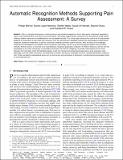| dc.contributor.author | Werner, Philipp | |
| dc.contributor.author | Lopez-Martinez, Daniel | |
| dc.contributor.author | Walter, Steffen | |
| dc.contributor.author | Al-Hamadi, Ayoub | |
| dc.contributor.author | Gruss, Sascha | |
| dc.contributor.author | Picard, Rosalind W. | |
| dc.date.accessioned | 2021-10-27T20:35:40Z | |
| dc.date.available | 2021-10-27T20:35:40Z | |
| dc.date.issued | 2019 | |
| dc.identifier.uri | https://hdl.handle.net/1721.1/136497 | |
| dc.description.abstract | IEEE Automated tools for pain assessment have great promise but have not yet become widely used in clinical practice. In this survey paper, we review the literature that proposes and evaluates automatic pain recognition approaches, and discuss challenges and promising directions for advancing this field. Prior to that, we give an overview on pain mechanisms and responses, discuss common clinically used pain assessment tools, and address shared datasets and the challenge of validation in the context of pain recognition. | |
| dc.language.iso | en | |
| dc.publisher | Institute of Electrical and Electronics Engineers (IEEE) | |
| dc.relation.isversionof | 10.1109/TAFFC.2019.2946774 | |
| dc.rights | Creative Commons Attribution-Noncommercial-Share Alike | |
| dc.rights.uri | http://creativecommons.org/licenses/by-nc-sa/4.0/ | |
| dc.source | Other repository | |
| dc.title | Automatic Recognition Methods Supporting Pain Assessment: A Survey | |
| dc.type | Article | |
| dc.contributor.department | Massachusetts Institute of Technology. Media Laboratory | |
| dc.relation.journal | IEEE Transactions on Affective Computing | |
| dc.eprint.version | Author's final manuscript | |
| dc.type.uri | http://purl.org/eprint/type/JournalArticle | |
| eprint.status | http://purl.org/eprint/status/PeerReviewed | |
| dc.date.updated | 2021-07-06T13:46:58Z | |
| dspace.orderedauthors | Werner, P; Lopez-Martinez, D; Walter, S; Al-Hamadi, A; Gruss, S; Picard, R | |
| dspace.date.submission | 2021-07-06T13:46:59Z | |
| mit.license | OPEN_ACCESS_POLICY | |
| mit.metadata.status | Authority Work and Publication Information Needed | |
